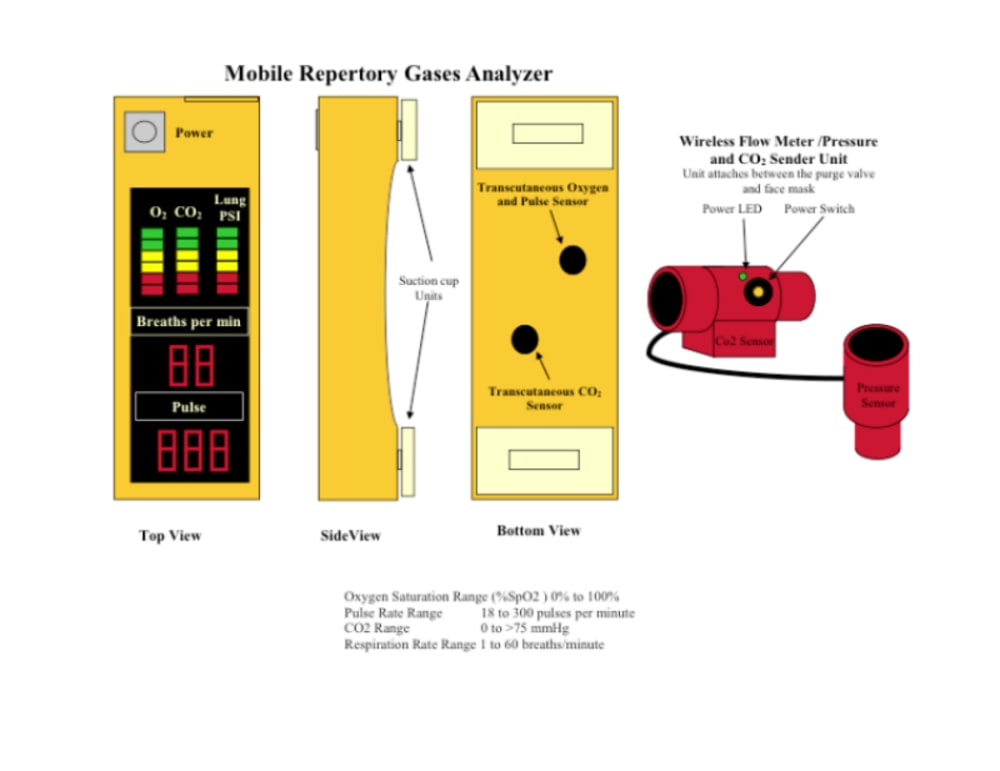Endotracheal intubation and mechanical ventilation are lifesaving interventions for accident victims who are unable to breathe for themselves. Medics currently have few methods for mechanically ventilating patients, and rely instead on manual bag-valve ventilation. Extensive pre-hospital studies data has shown that errors in ventilation (too much or too little) are common when the manual bag-valve method is performed. The same studies have shown that such errors are associated with increased mortality in patients with traumatic brain injury, since these patients are exquisitely sensitive to the effects of carbon dioxide on brain blood flow, and to inadequate oxygen levels. Data confirm that such errors are common in patients arriving to a Hospital.
The need for light, comfortable, easy to use and reliable Emergency Ventilation Monitor (EVM) is universally needed for mechanically ventilating patients. This system uses four different sensors to determine the patient condition.
1)The oxygen/pulse sensor - this unit determines thru transcutaneous contact with scalp the oxygen level of the blood and the current pulse , if any
2)The transcutaneous CO2 sensor - this unit also uses the scalp to monitor the CO2 levels in the blood and a microprocessor combines the information from the third sensor to calculate a more accurate PCO2 Level
3)The resuscitator CO2/ pressure sensor - this unit attaches to the resuscitator at the mask and monitor the pressure in the lungs, the number of times the lungs have been expanded per minute and the amount of CO2 exhaled
The ANT EVM would be placed on the forehead of the patient making it easy for the medic to see all of the sensor information while performing the manual ventilation procedure. This will allow the medic to adjust the amount of air and increase or decrease how often ventilation is done. It will provide the patient with a more reliable supply of oxygen to their blood stream and help keep the CO2 in balance. It will also help prevent hypoxia and keep the blood Ph balanced.
Illustration #1
The ANT EVM works by combining the sensory input from four different sensors to create an easy to read and understand display output. These sensors provide the onboard processor with the information it needs to accurately predict the patient’s PCO2, PO2 levels, pulse and lung pressure. The system records the number of times per minute the patient has been ventilated by the resuscitator bag.
The lungs are negatively pressurized and the EVM will help the medic to properly monitor pressurization of the lungs during ventilation. Over pressurization of the lungs can cause problems for the Heart. The face of the EVM is designed to be easy to read and interpret by keeping the 3 led bars in the green, ventilation is being done properly. The EVM uses a wireless network interface to monitor the Wireless Flow Meter/Pressure and CO2 Sender Unit attached to a standard Resuscitator between the mask to the resuscitator valve assembly and the exhaust vent to resuscitator valve assembly.
Illustration #2
Like this entry?
-
About the Entrant
- Name:Robert Decker
- Type of entry:teamTeam members:ANT, LLC. Robert Decker
- Hardware used for this entry:PCSoftware used for this entry:MS Publisher
- Patent status:none





